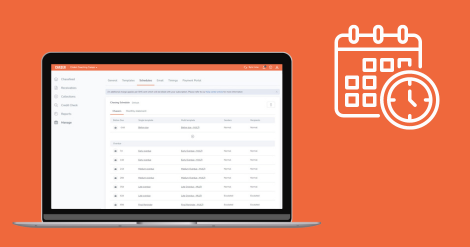Not many companies have a team of dedicated credit controllers in their finance team, but any company that wants to practice effective credit control should have regular credit control meetings - so problem invoices can be identified and addressed earlier, getting you paid sooner and minimising the chances of them turning into bad debts.
As well as holding effective credit control meetings, it's important to make sure your finance team are chasing customers in the best way possible! Download our popular PDF guide on the 8 most effective templates for getting invoices paid on time, just click here.
But today, we're sharing our 7 tips on how your finance team should be holding credit control meetings to get maximum effectiveness and efficiency.

1. Bank reconciliation before meetings
On the morning of the meeting, always ensure you complete your bank reconciliation. This is the only way to ensure you have the most accurate and up to date information you can about your paid and unpaid invoices - no great finance function can be built on inaccurate info, and the same goes for your credit control meetings.
2. Share an agenda
Set a written agenda and ensure everyone gets the opportunity to read it in advance of your credit control meeting. Entrepreneur.com agrees - so much so that they list it as their number one way to ensure meetings are productive. Although they tout a 24 hour advance circulation of the agenda, the necessity of performing your bank reconciliation on the morning of the meeting precludes this.
A circulation an hour in advance of the meeting provides the optimal balance between being able to craft an accurate and informative agenda whilst allowing attendees the time to read and digest it, coming into the meeting prepared and productive.
When you’re typing that agenda up, remember to include:
- The (problematic) invoices for discussion, highlighting the longest and monetarily largest overdue
- Communication history of these invoices (emails, notes, phone correspondence)
- The customers’ past payment trends
These make the cornerstone of every effective credit control meeting - they tell the story of your business, your customers, and your cashflow. If you want any hope of solving your payment problems, you need these.
3. Involve other teams (sometimes)
Dealing with problematic customers and unpaid invoices is a touchy area - in some cases, to preserve the relationship, the best person to liaise with the customer about an unpaid invoice doesn’t sit in the finance team.
Salespeople or account managers can be a great bridge between the finance team and a troublesome customer, more easily towing the line between firm and fair thanks to the relationship they’ve nurtured. With motivation potentially laying in the payment of commission, inviting these people to your credit control meeting can be extremely valuable. Not only can they offer input on the customer themselves, they can be useful to assign next actions to after the meeting.
Just make sure you cover off the invoices relevant to them at the start of the meeting - leaving them hanging around will be nothing but detrimental to eliciting their help again in the future.
4. Start with the biggest credit control issues first
In the words of Mark Twain:
"If it's your job to eat a frog, it's best to do it first thing in the morning. And If it's your job to eat two frogs, it's best to eat the biggest one first."
Effective credit control meetings treat this as a core philosophy. Start with the biggest and most important issues on the agenda (i.e. longest overdue and monetarily largest overdue invoices) to preclude the effects of decision fatigue, and to avoid an important point being missed from discussion due to running out of time.
5. Stick to the meeting agenda
Don't snack! And we’re not talking about food. Atlassian dig into the stats here about the real cost of meeting (un)productivity and reveal some shocking facts:
- 50% of meetings are considered time wasted
- 31 hours are spent in unproductive meetings every month
- $37 billion is wasted in salary costs from unnecessary meetings in the US alone
A major contributor to unproductivity in meetings is something productivity gurus call snacking. Snacking is the act of latching onto an easy topic and talking about it for longer than necessary because it’s easy. The biggest and most important issues (i.e. the ones you should be focusing on first) often seem difficult, perhaps even insurmountable, so we tend to subconsciously defer dealing with them by engaging in snacking.
Being aware of this during your credit control meetings will allow you to clamp down on it and ensure time and resources are used effectively and efficiently. Great agendas pre-emptively crack down on snacking by being highly selective.
6. Finish meetings strong and clear
When meetings come to a close, people are generally a combination of fatigued and relieved. This feeling can bring a really effective credit control meeting to its knees if you’re not careful. Without a crystal clear ‘next actions’, the momentum generated during the meeting is all but lost once everyone walks out the door.
This is where a great scribe wraps up the meeting with a summary of the actions noted against each problem invoice and the responsible parties for those actions. Raising this aloud gives everyone the opportunity to acknowledge what’s required of them, as well as raise any discrepancies. With corrections made, these actions should be collated and disseminated to all meeting attendees as soon as possible after the meeting’s close.
7. Schedule accordingly
Now that you’re ready to maximise the effectiveness of your credit control meetings, just how often should you be having them?
Depending on the size of your business, and your finance team itself, somewhere between weekly and fortnightly will give you the best frequency to ensure issues are identified, disseminated, and dealt with in due course. Your best bet is to test each, over a period of a month or so, to see what works best for your team.
Stretching out to monthly meetings can be dangerous, leaving your business vulnerable to unchecked problems, so if you find it hard to fit the meeting in every week or two, consider combining it into your regular finance meeting.
Want more?
In addition to having effective credit control meetings, it's important to make sure your team are chasing customers in the best way possible! You can download our tried and tested '8 most effective email templates for getting invoices paid' PDF guide here.
See how thousands of businesses are using Chaser to automate their invoice chasing and streamline their credit control processes, to get paid on time - in less time. Sign up for a 14 day free trial (no card details required) at: chaserhq.com/signup.




